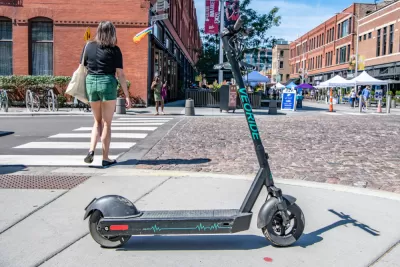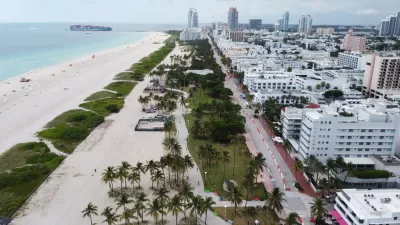As cities continue to adapt micromobility regulations to address new devices and technologies, what can we learn from Chicago's five years of e-scooter pilots?

Five years after shared e-scooter fleets first hit U.S. streets, Brandon Bordenkircher and Riley O'Neil assess the successes and challenges of scooter pilot programs around the country, particularly in Chicago. Speaking with city mobility leaders, the authors evaluate how the scooter companies fulfilled—or didn't—their early promises to cities.
Bordenkircher and O'Neil find that while many cities at first reacted by banning scooters, the devices have now become an important tool in improving mobility and providing options for underserved communities, but operators and cities have fallen short on safety and sustainability goals.
In Chicago, the city required that 50 percent of scooters would be placed in "equity zones," mandating coverage in low-income neighborhoods. However, equity advocates say increasing ridership also requires "community-led micromobility models such as neighborhood-based mobility hubs, non profit operators, and other innovative strategies that prioritize racial equity and mobility justice over profit."
When it comes to clutter and mobility, Chicago—which boasts some of the country's most robust bike parking infrastructure—requires scooter users to lock devices to a bike rack or other object, preventing the sidewalk clutter and inconvenience to pedestrians experienced in other cities.
While e-scooter fatalities remain rare, injuries are on the rise, and mobility advocates call on cities to improve infrastructure that would limit scooter-car interaction and reduce the chance of crashes. Meanwhile, despite claims that scooters provide a more environmentally friendly mobility option that can connect people to transit, the materials required to build the devices and the energy used in moving and collecting them, as well as the fact that many scooter trips could have been made by bike, on foot, or via public transit, mean that scooters do not make a meaningful impact on overall carbon emissions and resource use.
The article concludes that although the e-scooter industry has come a long way from its early days, more efforts are required to improve safety, equity, and sustainability and meaningfully integrate the devices into cities' transportation systems.
FULL STORY: Mobility leaders assess 5 years of e-scooters, and draw insights from the Chicago pilots

Study: Maui’s Plan to Convert Vacation Rentals to Long-Term Housing Could Cause Nearly $1 Billion Economic Loss
The plan would reduce visitor accommodation by 25,% resulting in 1,900 jobs lost.

North Texas Transit Leaders Tout Benefits of TOD for Growing Region
At a summit focused on transit-oriented development, policymakers discussed how North Texas’ expanded light rail system can serve as a tool for economic growth.

Why Should We Subsidize Public Transportation?
Many public transit agencies face financial stress due to rising costs, declining fare revenue, and declining subsidies. Transit advocates must provide a strong business case for increasing public transit funding.

How to Make US Trains Faster
Changes to boarding platforms and a switch to electric trains could improve U.S. passenger rail service without the added cost of high-speed rail.

Columbia’s Revitalized ‘Loop’ Is a Hub for Local Entrepreneurs
A focus on small businesses is helping a commercial corridor in Columbia, Missouri thrive.

Invasive Insect Threatens Minnesota’s Ash Forests
The Emerald Ash Borer is a rapidly spreading invasive pest threatening Minnesota’s ash trees, and homeowners are encouraged to plant diverse replacement species, avoid moving ash firewood, and monitor for signs of infestation.
Urban Design for Planners 1: Software Tools
This six-course series explores essential urban design concepts using open source software and equips planners with the tools they need to participate fully in the urban design process.
Planning for Universal Design
Learn the tools for implementing Universal Design in planning regulations.
Ascent Environmental
Borough of Carlisle
Institute for Housing and Urban Development Studies (IHS)
City of Grandview
Harvard GSD Executive Education
Toledo-Lucas County Plan Commissions
Salt Lake City
NYU Wagner Graduate School of Public Service





























